
* In the 1980s, an Austrian aircraft designer named Wolf Hoffman went into production with the "H36" two-seat motor glider, which proved popular. The H36 was followed by improved variants, and then the "D20" two-seat light airplane derived from it, the Hoffman firm having become "Diamond Aircraft" in the interim. The DA20 was followed by the "DA40" four-seater, and then the "DA42" twin-engine four-seater, with the DA42 proving notably popular in both civil and military roles. This document provides a history and description of the Diamond Aircraft family. A list of illustration credits is included at the end.
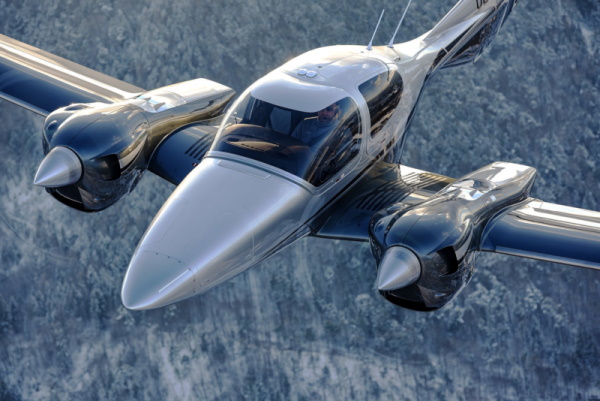
* The Diamond aviation firm of Austria traces its origins back to 1981, when aircraft designer Wolf Hoffman founded "Hoffman Flugzeugbau" in Friesach, Austria, to build his "H36 Dimona (Diamond)" motor glider, which Hoffman had flown the year before. It featured a fiberglass airframe, with side-by-side seating under a bubble canopy; wings that could fold for storage; airbrakes / lift dumpers above the wings; a tee tail; and fixed taildragger landing gear, with the main gear in spats.
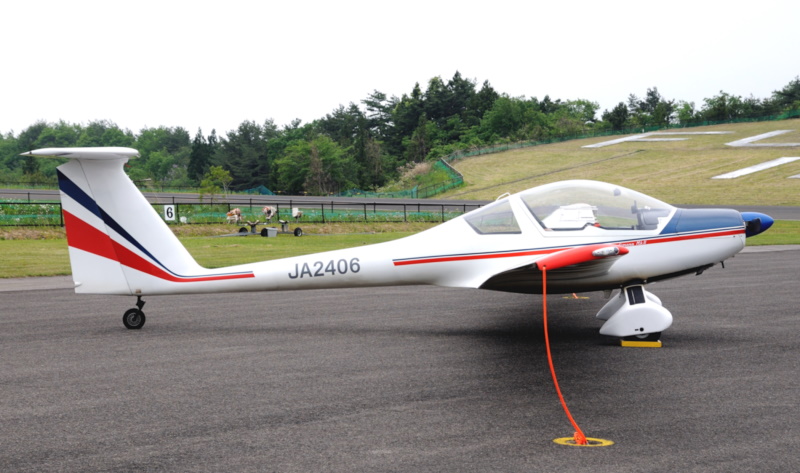
The H36 was powered by a flat-four engine driving a two-bladed variable-pitch prop. Powerplant options including a Limbach L2000 EB1C air-cooled engine, providing 60 kW (80 hp); a Rotax 912A water-cooled engine, providing 60 kW (80 hp); or a Limbach L2400 EB air-cooled engine, providing 65 kW (87 hp); the engine drove a two-bladed variable-pitch prop. The original wingspan was 16 meters (52 feet 6 inches), though later variants would have longer spans, and gross weight was 770 kilograms (1,700 pounds). Production switched to a "Mark 2" in 1985, with 275 H36s built to end of manufacture in 1989.
The H36 proving successful, the design was revamped by an engineer named Dieter Koehler, with the "HK36R Super Dimona" performing its initial flight in October 1989. The HK36R had a modified fuselage and a carbon-fiber wing spar -- with the wingspan extended to 16.2 meters (53 feet 1 inch), or optionally to 17.6 meters (57 feet 8 inches). It was powered by a 60 kW (80 HP) Rotax 912A engine.
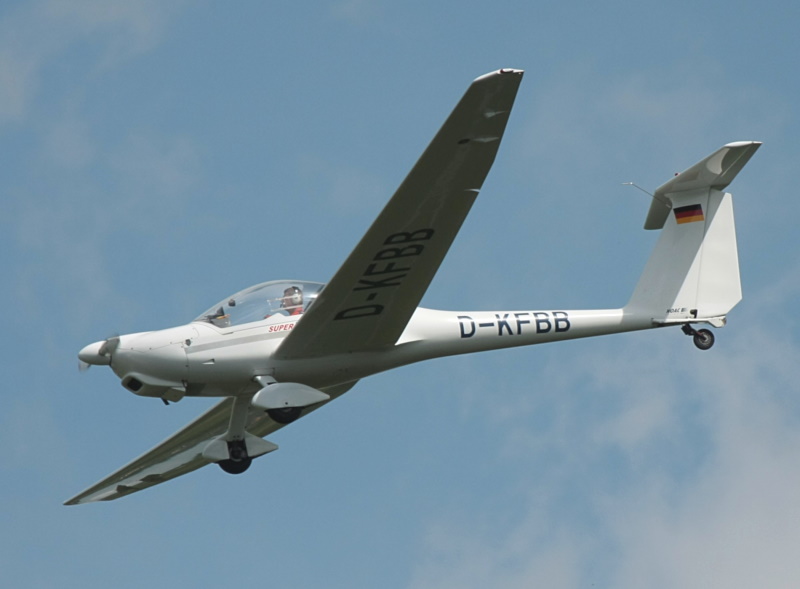
The HK36R led to a confusing range of follow-on variants, roughly as follows:
The Super Dimona was marketed as the "Katana Xtreme" -- a "katana" being Japanese for "blade", usually implying a samurai sword -- in North America. During the period of development of the Dimona series of motor gliders, Hoffmann Flugzeugbau underwent a set of buyouts and changes of names, becoming "Hoffman Aircraft LTD", and then "HOAC AG" -- with headquarters ending up in Vienna, and a factory set up in Wiener Neustadt.
___________________________________________________________________
HOAC HK36TTC-115 SUPER DIMONA:
___________________________________________________________________
wingspan:
16.33 meters (53 feet 7 inches)
length:
7.28 meters (23 feet 10 inches)
wing area:
15.3 sq_meters (164.7 sq feet)
height:
2.35 meters (7 feet 8 inches)
empty weight:
568 kilograms (1,252 pounds)
gross weight:
770 kilograms (1,697 pounds)
cruise speed:
260 KPH (160 MPH / 140 KT)
service ceiling:
5,000 meters (16,400 feet)
range:
920 kilometers (570 MI / 495 NMI)
___________________________________________________________________
In 2008, Boeing flew a "Fuel Cell Demonstrator (FCD)" aircraft based on the Super Dimona, but with an electric motor powered by a hydrogen fuel cell. Given the difficulties of producing and distributing hydrogen, that exercise went nowhere; more practically, in 2011, a "DA36 E-Star" hybrid aircraft took to the air, driven by a Siemens electric motor producing 70 kW (94 HP), with the power provided by a battery pack and an Austro Engines Wankel rotary motor, provided 30 kW (40 HP) to drive a generator. The objective was to cut fuel consumption and emissions by 25%. The Super Dimona remains in production, with over 900 sold to date.
BACK_TO_TOP* HOAC officials were encouraged by the success of the Super Dimona, and decided to develop a two-seat light aircraft based on it. The result, the "DV20-A1 Katana", performed its initial flight on 16 March 1991, and was certified in 1993. In 1992, HOAC had set up a manufacturing facility in London, Ontario, Canada, to serve the North American market, with the Katana being produced there as the "DA20-A1" -- for simplicity, this designation is preferred here. The Canadian operation, named "Diamond Aircraft", delivered its first DA20 in 1995. In 1996, time, the Austrian parent company took on the name of "Diamond Aircraft GMBH", which it still retains.
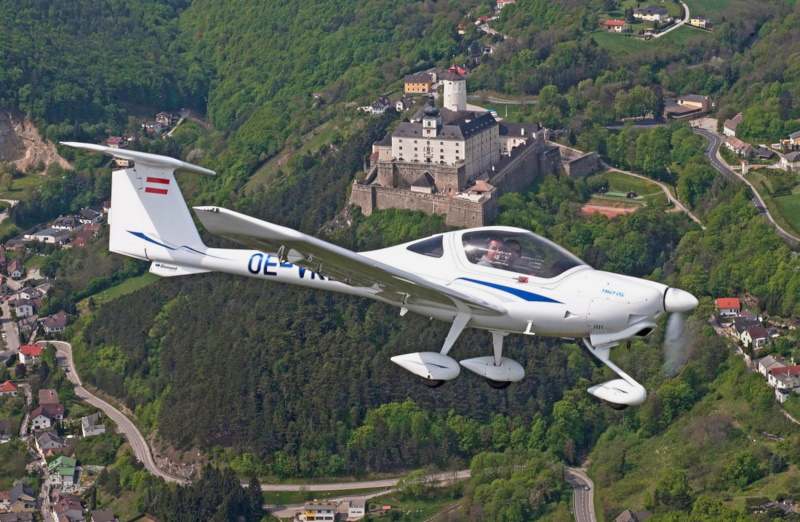
The DA20 Katana was, in effect, just a Super Dimona in fixed tricycle landing gear configuration with short wings, featuring winglets. The DA20-A1 was powered by a Rotax 912 engine providing 60 kW (80 HP), driving a two-bladed variable-pitch propeller -- from late in the decade, a re-engining program was offered to upgrade older Katanas with a 75 kW (100 HP) Rotax 912S engine.
The DA20-A1 was followed in 1998 by the "DA20-C1", the primary change being introduction of the Continental IO-240 flat-four air-cooled engine, providing 95 kW (125 HP). The more powerful and heavier engine required some internal re-arrangement of systems; a slightly increased wing sweep; and slotted flaps, instead of the simple hinged flaps of the DA20-A1.
___________________________________________________________________
DIAMOND DA20-C1:
___________________________________________________________________
wingspan:
10.87 meters (35 feet 8 inches)
length:
7.16 meters (23 feet 6 inches)
wing area:
11.6 sq_meters (125 sq feet)
height:
2.18 meters (7 feet 2 inches)
empty weight:
528 kilograms (1,164 pounds)
gross weight:
800 kilograms (1,764 pounds)
cruise speed:
255 KPH (160 MPH / 140 KT)
service ceiling:
4,000 meters (13,100 feet)
range:
1,015 kilometers (630 MI / 545 NMI)
___________________________________________________________________
There were several subvariants of the DA20-C1, including:
From 1999, the Aspen E1000 flight display or, for more money, Garmin G500 glass cockpit were offered as options for the DA20. The DA20 remains in production, with over a thousand built to date.
BACK_TO_TOP* The DA20 was followed later in the decade by the "DA40 Diamond Star", which was a four-seat aircraft derived from the DA20. Its general configuration was much like that of the DA40 -- composite construction, fixed tricycle landing gear, tee tail -- but it was about 50% heavier, and could be recognized by the substantially bigger cockpit. Flight controls remained conventional and manual, including flaps, ailerons, elevators, rudder, and pitch trimmers. Seating was in a 2 x 2 arrangement, with the canopy hinging forward to give access to the front seats, and an upward-hinged door to give access to the rear seats. Fuel was in a tank in each wing.
Initial flight of the first prototype, powered by a Rotax 914, was on 5 November 1997, being followed by a second prototype with a Continental IO-240, and a third with a Lycoming IO-360 flat-four air-cooled engine. The initial production variant, the "DA40-180", was powered by a Lycoming IO-360 M1A engine with 135 kW (180 HP), driving a three-bladed variable-pitch propeller from MT of Germany. Unlike the DA20, the DA40 was also kitted and qualified for instrument flight in low-visibility conditions.
In 2006, the DA40-180 was replaced by two new models, both of which featured small airframe tweaks acquired during production, the high-end "DA40 XL" and the low-end "DA40 FP". The DA40 XL improved performance by adding a "tuned" exhaust system, which reduced back pressure and improved engine efficiency. It didn't result in any increase in top horsepower, but it allowed the aircraft to sustain higher cruise horsepower, and provided an increment of maximum take-off weight.
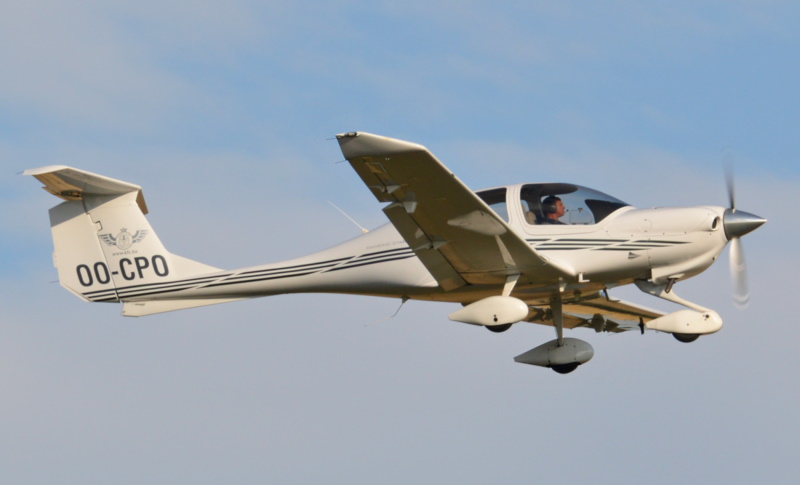
Other changes included winglets and a new MT three-bladed scimitar prop that was lighter and more efficient, as well as making a range of tweaks in kit. Elements of the DA40 XL could be retrofitted to the DA40-180. The Garmin G1000 glass cockpit was standard.
___________________________________________________________________
DIAMOND DA40 XL:
___________________________________________________________________
wingspan:
11.9 meters (39 feet 2 inches)
length:
8.1 meters (26 feet 5 inches)
wing area:
13.5 sq_meters (145.3 sq feet)
height:
1.98 meters (6 feet 6 inches)
empty weight:
795 kilograms (1,755 pounds)
MTO weight:
1,198 kilograms (2,645 pounds)
cruise speed:
280 KPH (175 MPH / 150 KT)
service ceiling:
5,000 meters (16,400 feet)
range:
1,340 kilometers (830 MI / 720 NMI)
___________________________________________________________________
The "DA40 FP" was fitted with a two-bladed fixed-pitch Sensenich prop, hence the "FP" suffix. It also was powered by an IO-360-A4M engine, which was carbureted instead of fuel-injected, and featured a low-price cockpit and trim fit.
The DA40 XL was quickly followed by the "DA40 XLS", which was more of the same, featuring a new canopy that provided more room; new "Platinum" interior and fancy trim; and a Garmin G1000 system with new bells and whistles, such as an engine-monitoring display. It led in 2013 to the "DA40 XLT", with an updated interior and more bells and whistles.
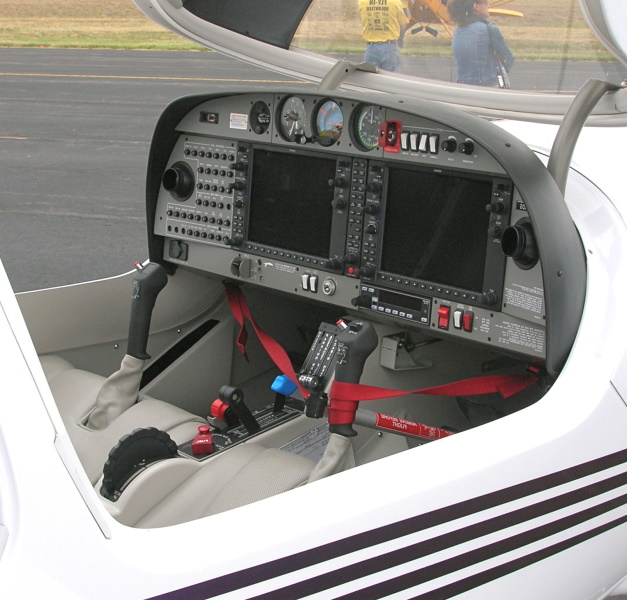
The DA40 XLS was accompanied by the "DA40 CS", which was effectively a stripped-down DA40 XLS -- fitted with a two-bladed Hartzell constant-speed prop -- that could be selectively enhanced from a menu of options. The DA40 FP was discontinued; it appears the bare-bones fixed-pitch prop option wasn't popular.
From early on, the DA40 also featured a diesel-powered line, starting with the "DA40 D" AKA "DA40 TDI", powered by a Thielert Centurion TAE-125 engine providing 100 kW (135 HP), and a three-bladed MTV propeller. As discussed below, Thielert went broke, and so Diamond introduced the "DA40 NG", with an Austro Engines AE300 diesel, providing 125 kW (170 HP). A "DA40 Tundra Star" was also introduced, with the same powerplant, but ruggedized landing gear, larger low-pressure tires, and other optimizations for rough-field operation.
From 2018, Diamond test-flew a DA40 with a hybrid propulsion system, with twin electric motors on a canard foreplane driving props, a battery pack in the rear cabin, and a 110-kW Austro Engines AE300 diesel generator installed in the nose. It was put together in collaboration with German electronics giant Siemens as an experiment; there is no intent to bring it to production.
* The DA40 remains in production, over 2,200 having been built. Diamond has developed a "DA50 Superstar" -- an enlarged DA40 with five seats -- with a prototype flying in 2007, powered by a Continental TSIOF-550 flat-four engine, featuring dual turbochargers and 260 kW (350 HP). Its dimensions were increased by about 7%, with a wingspan of 11.68 meters (38 feet 4 inches) and a length of 8.81 meters (28 feet 11 inches). It featured a pressurized cockpit, with an upward-hinged door on the left front -- replacing the forward-hinged canopy -- and upward-hinged doors on both sides of the rear.
The Superstar prototype was followed by a prototype of the "DA50 Magnum", with initial flight on 14 March 2008, the primary change being fit of the AE300 diesel. Due to the economic downturn and a temporary shift in focus, the DA50 was put on the back burner in 2009. However, Diamond then went on to develop a turboprop-powered version, the "DA50-JP7", the engine being an AI-450S turboprop from Motor Sich of Ukraine, with 345 kW (450 HP). Initial flight was on 19 January 2015.
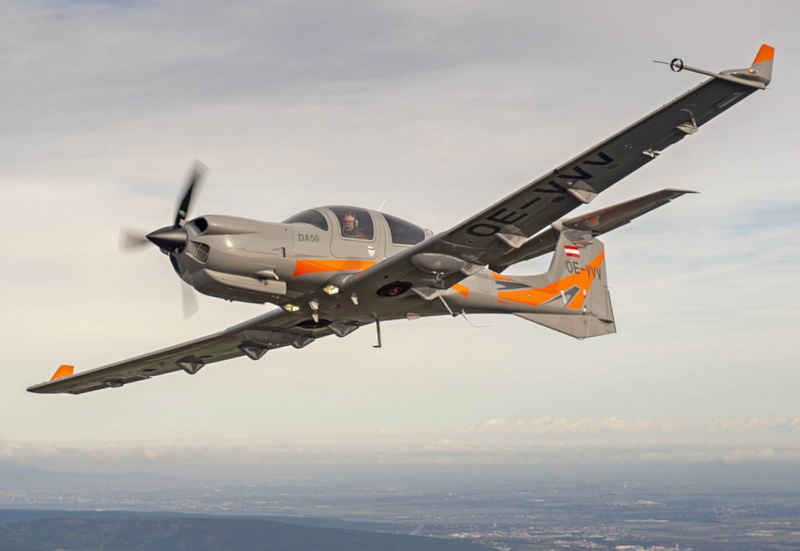
In 2017 the company announced that three baseline versions were to be sold, all with Safran/SMA diesels, not the AE300, with further talk of a Lycoming gasoline engine, and with the Motor Sich AI-450S. However, production machines were not forthcoming. A prototype "DA50 RG" with retractable landing gear and a Continental C-300 diesel engine, providing 225 kW (300 HP), was flown in late 2019, with initial certification in 2020 and deliveries from 2024.
* Following up on the DA40, Diamond went on to a four-seat twin, the "DA42 Twin Star", which performed its initial flight on 9 December 2002, and was certified in 2004. The Twin Star features an elegant airframe, made largely of composite materials, and retractable tricycle landing gear. The wing features winglets; the tailfin is swept, with a forward fillet, and a ventral fin. All landing gear assemblies have single wheels, the nose gear retracting forward, the main gear hinging in from the wings toward the fuselage. The main wheels have no covers. There was talk of a floatplane version, but little evidence it ever happened.
The general seating and access configuration is as per the DA40. The cockpit features a roll bar. There's a baggage hold behind the rear seats and in the nose, with upward-hinged doors on each side of the nose. The DA42 features a Garmin G1000 glass cockpit as standard.
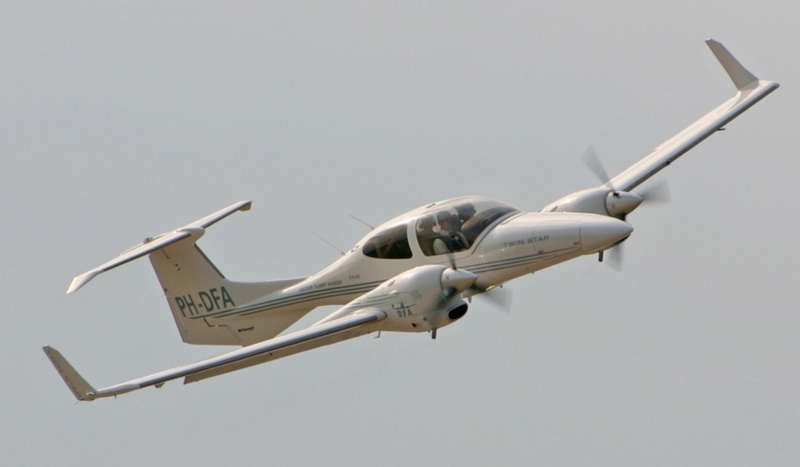
Originally, the DA42 was powered by twin Thielert Centurion diesel engines, driving MT three-bladed composite variable props, with the Lycoming IO-360 gasoline engine offered as an option. The original Thielert powerplant had 1.7 liters displacement and provided 100 kW (135 HP); it was later replaced by a 2-liter version, derated for the DA42 to the same power levels. However, Thielert went bankrupt in 2008; Diamond was already in a difficult position, the global recession that began in 2007 having squeezed the company. DA42 production was shut down for the time being, with many workers laid off.
The company decided to manufacture their own diesel engine, the "Austro Turbo (AE300)", with 125 kW (168 HP) and improved fuel economy, through the firm's Austro Engine GMBH spin-off. The aircraft was re-certified in 2009 as the "DA42 NG". Diamond has worked to reduce airframe weight of the DA42, while increasing maximum takeoff weight to provide more payload or endurance. Development is also underway for a fly-by-wire flight control system for the DA42 NG, the focus being on improvement of flight safety, with features such as flight envelope protection, automatic turbulence righting, auto-landing, and "bypass" flight control when the aircraft's control system is damaged.
___________________________________________________________________
DIAMOND DA42 NG:
___________________________________________________________________
wingspan:
13.5 meters (44 feet 4 inches)
length:
8.56 meters (28 feet 1 inch)
wing area:
16.4 sq_meters (176.6 sq feet)
height:
2.5 meters (8 feet 2 inches)
empty weight:
1,430 kilograms (3,155 pounds)
MTO weight:
1,900 kilograms (4,190 pounds)
cruise speed:
275 KPH (170 MPH / 150 KT)
service ceiling:
5,485 meters (18,000 feet)
take-off run:
700 meters (2,300 feet)
landing roll:
570 meters (1,870 feet)
range:
1,695 kilometers (1,050 MI / 915 NMI)
___________________________________________________________________
The newest version is the "DA42-VI", introduced in 2012, with aerodynamic improvements to enhance cruise speed, along with updated avionics and trim. Well over 600 have been sold to date.
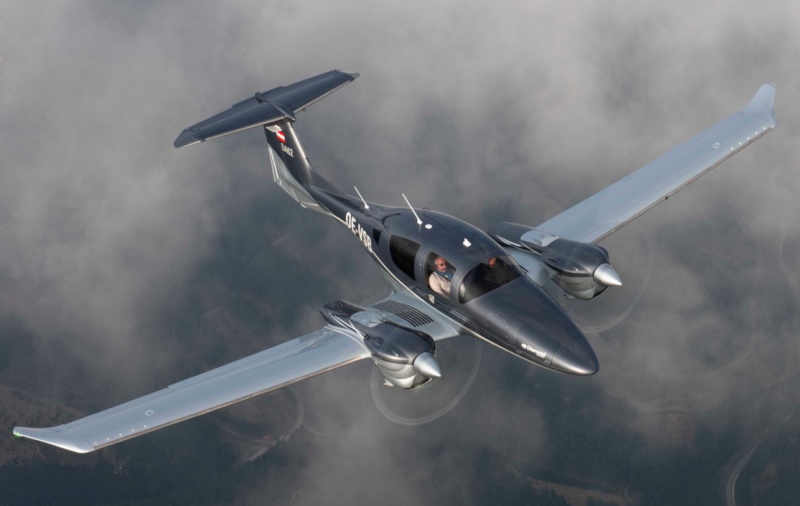
In 2013, Diamond unveiled a "DA52", later "DA62", derivative of the DA42, modified for five or seven seats -- five seats for European sales, seven seats for North American sales. The difference in seating was due to the different regulatory environments across the Pond, five seats keeping the DA62 under the 2,000-kilogram (4,400-pound) maximum take-off limit, above which the European air traffic control system imposes user fees.
The DA62 was hard to distinguish from the DA42, but was stretched about 7% -- with a wingspan of 14.5 meters (47 feet 7 inches) and a length of 9.19 meters (30 feet 2 inches) -- and of course had a completely redesigned cabin, much like that of the DA50, with three upward-hinged doors. The most visible recognition figure was the revised cockpit, which had a third small window at the rear on each side. The DA62 featured uprated AE330 engines, with 135 kW (180 HP), to handle the increased take-off weight. Certification was in 2015, with initial deliveries in 2016, and over a hundred sold to date. Diamond has mentioned a turboprop derivative, presumably with the AI-450S.
BACK_TO_TOP* While the DA42 was designed for civil use, it has proven popular in military and paramilitary roles, and indeed the company is now heavily reliant on government orders. In 2005, Diamond -- working with Rheinmetall Defense Electronics GMBH -- flew a special mission demonstrator designated the "Optionally Piloted Surveillance & Reconnaissance System (OPALE)", with an undernose imager turret, a datalink system, and provision for drone operation.
The OPALE demonstrator led to the "DA42 Guardian Multi-Purpose Platform (MPP)". It featured an engine "hushkit" and exhaust infrared suppressors, though the suppressors were mainly intended to prevent interference with sensors and not to foil heat-seeking missiles. The basic sensor was a laser scanner system linked to GPS; electro-optic or infrared sensors, or a synthetic-aperture radar (SAR), could be carried as well. Sensors were carried in the nose, which could be fitted with an undernose turret; or under the belly, a radar often being fitted in the belly position. Sensor data could be downloaded to a ground station via a datalink. The tailfin featured inverted winglets, presumably to compensate for the aerodynamic interference of sensor payloads.
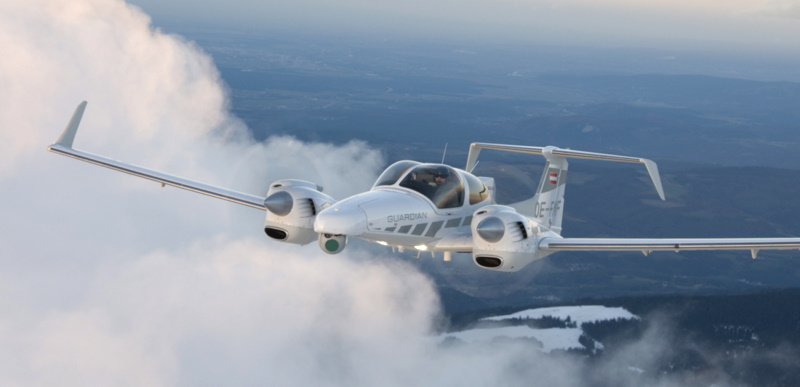
The aircraft could accommodate a pilot, copilot, and one or two sensor operators -- the number of crew depending to a degree on the weight of payload. An ocean surveillance configuration has been promoted, equipped with a maritime search radar and a satcom datalink. A long-range fuel tank with 50% more capacity is offered as an option.
The DA42 MPP is being offered for both military and civilian users, with users able to install their own payload suites. The relatively low purchase and operating cost of the DA42 makes it attractive, particularly to military services on a budget; the fact that it is such a pretty aircraft can't hurt. The DA42 MPP has been obtained by Ghana, Niger, Thailand, Switzerland, and Ukraine. The British Royal Air Force leased two for surveillance in Iraq and Afghanistan during 2008:2009, and one was also used for surveillance of the London Olympics in 2012. UK-based Flight Calibration Services operates a set of DA42s, fitted out for the flight systems calibration role.
The DA62 is also being offered in special-mission configurations, Nigeria having obtained four MPPs. It is also offered as a "Maritime Surveillance Aircraft (MSA)", a coastal-patrol version with search radar, an undernose EO-IR turret, a signals intelligence (SIGINT) receiver, and a mission-management system. It was developed in collaboration with Italian aerospace giant Leonardo.
* Aeronautics Defense Systems of Israel developed a drone version of the DA42 named the "Dominator 2", with a faired-over canopy and drone avionics systems, including an EO turret under the nose. Other payloads of up to 300 kilograms (660 pounds) were possible. Mission endurance was up to 28 hours. A prototype flew in 2009, but it doesn't appear anyone was interested.
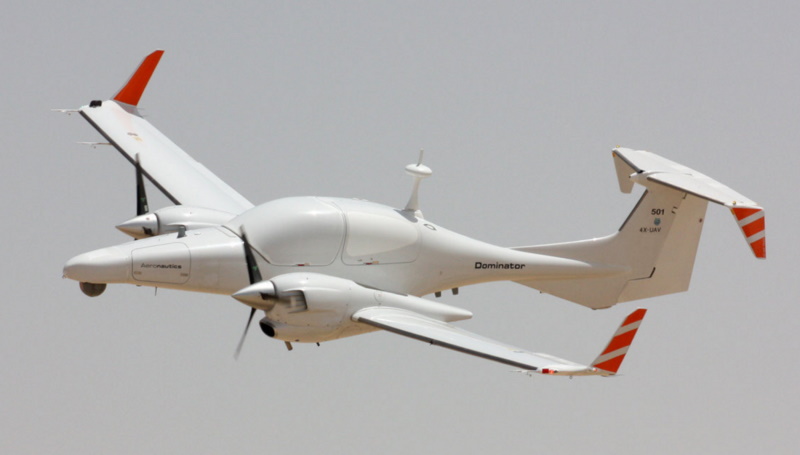
The Chinese defense electronics firm CETC builds the DA42 under license. The company offers Guardians with kit as per customer requirement, with at least four basic configurations:
CETC produces the AE300 engines for the DA42s under license in China.
BACK_TO_TOP* Diamond has been pushing a military trainer turboprop, the "Diamond Aircraft Reconnaissance Trainer (DART)", with initial flight of the first prototype "DART 450" on 17 May 2016. The DART 450 was of typical military turboprop trainer configuration, similar to that of the Embraer Super Tucano or Pilatus PC-21 -- though smaller, with only about half the empty weight of those two aircraft.
As introduced, the DART was of largely composite construction. It had a low, slightly swept wing with upturned wingtips; a tapered tailplane with slightly downturned tips and root extensions; a swept tailfin with a prominent forward fillet; seats in tandem under a one-piece canopy that tilts open to the right, the back seat being raised to give the instructor a better forward view; and tricycle landing gear, all assemblies with single wheels, the nose gear retracting backward, the main gear pivoting inward from the inner wings towards the fuselage.
Flight control surfaces were conventional, with ailerons, double slotted flaps, elevators, rudder, and trim tabs. The aircraft was flown with a sidestick controller; flight control was originally power-boosted manual, but the intent is to develop a fly-by-wire system. The canopy was hardened against bird strikes, and the landing gear was suited to rough-field operation. The DART 450 was powered by an AI-450SD turboprop engine from Ivchenko Progress / Motor Sich with 335 kW (450 SHP), featuring dual full-authority digital engine control (FADEC) and driving a five-bladed MT propeller. Maximum endurance was eight hours.
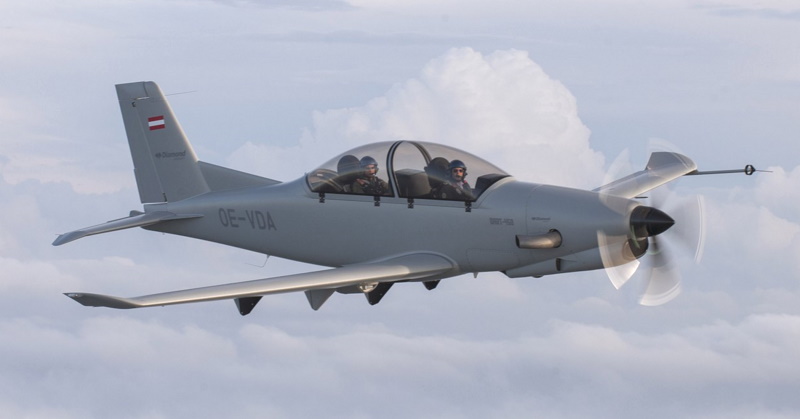
Each crew member had a Garmin glass cockpit, with both sitting on Martin-Baker Mark 16 lightweight ejection seats. There was a hatch under the rear fuselage for a retractable sensor turret. No images showed the DART 450 could haul underwing stores; given its small size, it wouldn't be able to handle munitions much bigger than those hauled by tactical drones, and it also would not be able to carry much armor to make it suitable for combat.
A prototype for a "DART 550" first flew in May 2018; it was the same as the DART 450, but had a General Electric H75-100 turboprop engine with 410 kW (550 SHP). A "DART 750" prototype first flew in June 2023, this machine fitted with a Pratt & Whitney Canada PT6A-25C turboprop with 550 kW (750 SHP).
___________________________________________________________________
DIAMOND DART 450:
___________________________________________________________________
wingspan:
11.74 meters (38 feet 6 inches)
length:
10.75 meters (35 feet 3 inches)
height:
3.38 meters (11 feet 1 inch)
empty weight:
1,330 kilograms (2,930 pounds)
MTO weight:
2,300 kilograms (5,070 pounds)
maximum speed:
460 KPH (290 MPH / 250 KT)
cruise speed:
430 KPH (260 MPH / 230 KT)
service ceiling:
7,010 meters (23,000 feet)
take-off run:
600 meters (2,000 feet)
landing run:
400 meters (1,300 feet)
range:
2,800 kilometers (1,700 MI / 1,500 NMI)
___________________________________________________________________
It is not clear if any DART machines have been sold. Diamond has mentioned selling a few in kit for to an undisclosed customer. CETC of China has an arrangement with Diamond to build a DART 450 with Chinese avionics, with this machine designated the "T-20". Initial flight of a prototype was in June 2023.
* As another footnote, in 2017 Diamond announced development work on the "Diamond Aircraft Rotary Trainer (DART) 280" -- a light piston-powered helicopter with four seats, in a league with the popular Robinson R44 helicopter. According to Diamond officials, the DART 280 was to be a lightweight, affordable, easy-to-fly helicopter for training and personal transport markets.
The DART 280 was to be of composite construction. It is projected to have a maximum take-off weight of 1,350 kilograms (2,500 pounds); a payload of 560 kilograms (1,235 pounds); energy-absorbing retractable landing gear; a shrouded, electric tail rotor; and a four-stroke jet-fuel engine providing 210 kW (280 SHP). Initial flight was expected in 2018, but it appears there wasn't enough market interest to make it happen.
BACK_TO_TOP* As yet another a footnote, in 2003 Diamond Aircraft announced that development had begun on a "very light jet (VLJ)" -- essentially a small business jet -- to be named the "Diamond D-Jet", with most of the work conducted at the Ontario facility. The effort was publicly announced in 2003, with initial flight on 18 April 2006.
The D-Jet was a low-wing aircraft of composite construction, the wing being moderately swept and with winglets, with a swept tailfin featuring a forward fin fillet, and a straight tee tailplane. It was powered by a Williams FJ33-4 turbofan, with 6.23 kN (635 kgp / 1,400 lbf) thrust, fed by inlets in the wing roots. It had tricycle landing gear, all gear assemblies with single wheels, the nose gear retracting forward, the main gear pivoting in the wings towards the fuselage.
There were seats for four passengers, along with a pilot, in a pressurized and climate-controlled cabin. There was a split door on the left front fuselage, the bottom half of the door acting as an airstair. There was a baggage hold in the rear, with a door on the left, and baggage storage in the nose, with doors on both sides. The D-Jet was fitted with a Garmin 1000 glass cockpit. Span was 11.43 meters (37 feet 6 inches), length was 10.69 meters (35 feet 1 inch), and empty weight was 1,175 kilograms (2,590 pounds). Cruise speed was 585 KPH (365 MPH / 315 KT), and range was 1,875 kilometers (1,165 miles / 1,010 NMI).
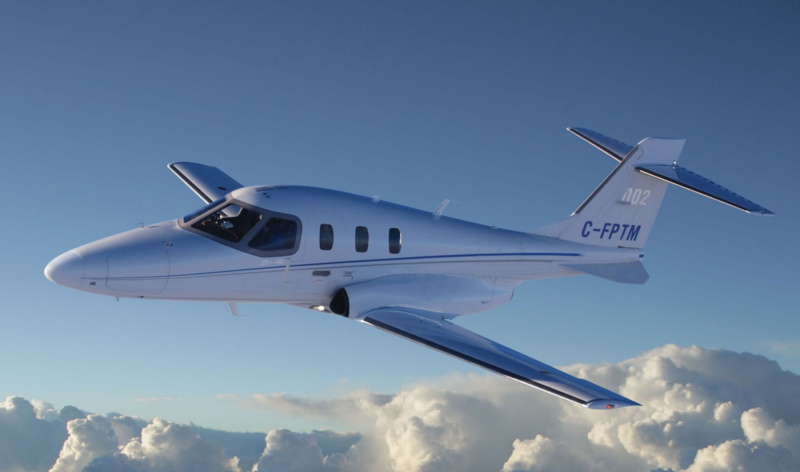
Trainer and drone derivatives were considered -- but due to the recession and other difficulties, the D-Jet program was suspended in 2011, with most of the staff laid off. Wanfeng Aviation, a Chinese firm, obtained a majority stake in Diamond Canada in 2016, but nothing more has been heard of the matter.
* Most of the details in this document were obtained from various volumes of JANE'S ALL THE WORLD AIRCRAFT, from the online Wikipedia, and the Diamond website.
* Illustrations details:
* Revision history:
v1.0.0 / 01 mar 16 v1.0.1 / 01 feb 18 / Review & polish. v1.1.0 / 01 mar 20 / DART 450, other updates. v1.2.0 / 01 jan 22 / Review, update, & polish. v1.2.1 / 01 dec 23 / Review, update, & polish.BACK_TO_TOP
